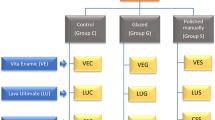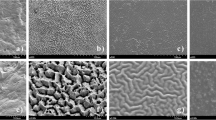Abstract
Adherent bacterial cells on the surfaces of two dental porcelain ceramics, three composite resins and human enamel were examined using four types of bacteria strains. Their adherent cells were counted on saliva-coated and uncoated material surfaces after sonication, and contact angle and ζ potential were measured for each adherent cell tested. A correlation between contact angle and bacterial cells on an uncoated surface was found to be higher in two Streptococcus sanguis cells than in S. mutans Ingbritt and S. sobrinus OMZ 176, whereas there appeared to be a higher correlation between S. mutans Ingbritt or S. sobrinus OMZ 176 and ζ potential on the uncoated surface. On the saliva-coated surface, a significantly high correlation was found between the adherent cells, with the exception of S. sanguis ATCC 10 557, and the ζ potential. Contact angle and ζ potential values were small when the surfaces of the materials were coated with saliva, as compared with those on the uncoated surface. The sonication condition (120 s) of adherent cells on the surface of the material significantly depended on the types of bacteria cells, showing that S. mutans Ingbritt (>50–60%) had a greater removal percentage than the others (<50%). © 1998 Chapman & Hall
Similar content being viewed by others
References
A. D. Wilson and B. E. Kent, J. Appl. Chem. Biotechnol. 21 (1971) 312.
Idem, Brit. Dent. J. 132 (1972) 133.
K. Neda, H. Kawasaki, A. Kuratate and Y. Hosoda, Nihon Shikahozongaku Zasshi 23 (1980) 584.
S. Crisp, B. G. Lewis and A. D. Wilson, J. Dent. Res. 55 (1976) 1032.
N. Satou, A. Morikawa, H. Urabe, H. Shintani, K. Wakasa and M. Yamaki, J. Mater. Sci. Mater. Med. 6 (1995) 749.
C. J. Palenik, M. J. Behnen, J. C. Setcos and C. H. Miller, ibid. 3 (1992) 16.
H. Komatsu, Nihon Shikahozongaku Zasshi 24 (1981) 814.
A. M. Bourke, A. W. G. Walls and J. F. Mccabe, J. Dent. 20 (1990) 115.
M. Yamaki, “Saishin Shika Rikougaku” Shoin, Tokyo, 1989) pp. 309-17.
K. Hinoura, M. Miyazaki and H. Onose, J. Dent. Res. 70 (1991) 1542.
M. L. Swartz, R. W. Phillips and H. E. Clark, ibid. 63 (1984) 158.
J. T. Davies and E. K. Rideal, “Interfacial phenomena” (Academic Press, New York, 1963).
Author information
Authors and Affiliations
Rights and permissions
About this article
Cite this article
YOSHIDA, Y., WAKASA, K., KAJIE, Y. et al. Adherent bacteria cells in five dental materials: sonication effect. Journal of Materials Science: Materials in Medicine 9, 117–120 (1998). https://doi.org/10.1023/A:1008807300825
Issue Date:
DOI: https://doi.org/10.1023/A:1008807300825




